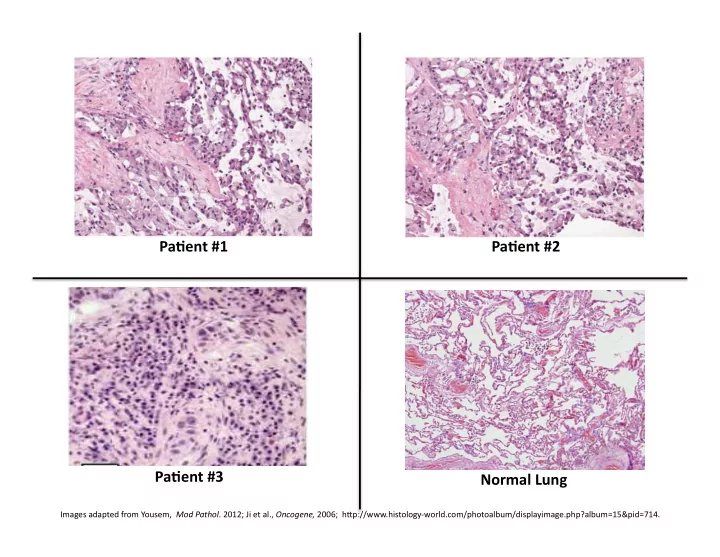

Pa#ent ¡#1 ¡ ¡ Pa#ent ¡#2 ¡ Pa#ent ¡#3 ¡ ¡ Normal ¡Lung ¡ Images ¡adapted ¡from ¡Yousem, ¡ ¡ Mod ¡Pathol . ¡2012; ¡Ji ¡et ¡al., ¡ Oncogene, ¡ 2006; ¡ ¡h;p://www.histology-‑world.com/photoalbum/displayimage.php?album=15&pid=714. ¡
Different Types of Cancer Treatments Anti-cancer drugs Surgery Radiation
Two types of anti-cancer drugs Targeted ¡therapy ¡ Chemotherapy ¡ Drug Target Protein ErloQnib ¡binding ¡to ¡mutant ¡form ¡of ¡EGFR ¡ CisplaQn ¡binding ¡to ¡DNA ¡Polymerase ¡ (which ¡is ¡a ¡form ¡of ¡EGFR ¡that ¡is ¡only ¡present ¡in ¡cancer) ¡ (an ¡enzyme ¡that ¡replicates ¡DNA, ¡and ¡is ¡acQve ¡in ¡all ¡ growing ¡& ¡dividing ¡cells) ¡ Protein ¡structures ¡adapted ¡from ¡Protein ¡Databank ¡(PDB) ¡h;p://www.rcsb.org/pdb/home/home.do ¡
1) Fill in this table with whether each treatment would work, or not 2) Which is the best way to treat a work, to treat each kitchen-related problem: kitchen with an out-of-control coffee maker? In ¡a ¡kitchen ¡with ¡an ¡ In ¡a ¡kitchen ¡with ¡an ¡ out-‑of-‑control ¡ ¡ out-‑of-‑control ¡blender ¡ coffee ¡ ¡maker ¡ 3) Which is the best way to treat a Use ¡a ¡lid ¡ kitchen with an out-of-control blender? Use ¡a ¡rubber ¡stopper ¡ 4) Which treatment works to treat the out-of-control appliance, but also yields other negative side effects to Turn ¡off ¡power ¡to ¡the ¡ the kitchen? whole ¡kitchen ¡
Maternal These are still homologs. Paternal DNA Replication “ Homologs ” are versions “ Sisters ” are of chromosomes – one replicates of each from the mother, and one other, and are formed from the father. after DNA replication.
Pa#ent ¡#1 ¡ ¡ Pa#ent ¡#2 ¡ Pa#ent ¡#3 ¡ ¡ Normal ¡Lung ¡ *Gene A has been dyed red and Gene B has been dyed green. If both genes come together at the same location due to a change in the DNA, then the area appears yellow. Images adapted from Koivunen J P et al. Clin Cancer Res , 2008.
Large Rearrangement CGCATCGAAGTCGATGCGATGCATGCGCTGCATCGATTGCATGTTCAGTACAGATT CGCGACATGACTTGTACGTTAGCTACGTCGCGTACGTAGCGTAGCTGAAGCTAATT Single Point Mutation CGCATCGAAGTCGATGCGATGCATGCGCTGCATCGATTGCATGTTCAGTACAGATT CGCATCGAAGTCGAAGCGATGCATGCGCTGCATCGATTGCATGTTCAGTACAGATT
EGFR ¡sequencing ¡chromatograms ¡ KRAS ¡sequencing ¡chromatograms ¡ Pa#ent ¡#1 ¡ ¡ Pa#ent ¡#1 ¡ ¡ Pa#ent ¡#2 ¡ ¡ Pa#ent ¡#2 ¡ ¡ Pa#ent ¡#3 ¡ ¡ Pa#ent ¡#3 ¡ ¡ Normal ¡lung ¡ Normal ¡lung ¡
Based on the data that you gathered and the data on the response rates in the table provided, how would you treat each patient? n/a: ¡data ¡are ¡not ¡available ¡for ¡these ¡mutaQon/drug ¡combinaQons ¡ *includes ¡paQents ¡from ¡all ¡categories ¡ Data adapted from Jänne et al., Clin Cancer Res . 2006; Jackman et al., Clin Cancer Res . 2009; Shaw et al, Nat Rev Drug Disc . 2011; Mok et al., New Eng J Med . 2009; Eberhard et al. , J Clin Oncol 2005; Vittorio et al., J Clin Oncol 2008.
Distribution of Genetic Mutations Known to Cause Lung Cancer Data adapted from Pao et al., Lancet Oncology 2011.
Recommend
More recommend